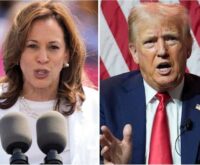Is Charlie Chan really dead?by Yayoi Lena Winfrey, AAV Contributing Editor There’s one of Curt Jurgens, a German, playing a Chinese general in Inn of the Sixth Happiness. Another shows Austrian Luise Rainer in her Oscar-winning role as the Chinese heroine of The Good Earth. Yet another features American Mickey Rooney with bucked teeth and thick eyeglasses, playing a Japanese in Breakfast at Tiffany’s. And who could forget John Wayne (who proclaimed the Negro’s inferiority to whites in a 1970’s Playboy magazine article) in the role of Mongol Genghis Khan in 1956’s The Conqueror? Caucasian Myrna Loy made a career of playing Asian characters in over a dozen films, while Chinese detective Charlie Chan, modeled after a real-life Honolulu private eye, was portrayed by several white actors including Warner Oland, Sidney Toler, and Peter Ustinov. One of the more recent and bizarre acts of yellowface casting was the choice of white actress Linda Hunt in the role of a Chinese-Australian man, Billy Kwan, in The Year of Living Dangerously.
Miss Saigon, MANAA, and the ExhibitJan-Christopher Horak’s interest in curating a yellowface exhibit began when he read a newspaper editorial penned by MANAA (Media Action Network for Asian Americans) president Guy Aoki. In his article, Aoki compared yellowface to the theatrical practice of blackface, which had been condemned in Spike Lee’s Bamboozled. A watchdog group that monitors media images of Asians, MANAA meets monthly in Los Angeles’ Little Tokyo. Having just viewed Bamboozled, Horak was moved to phone Aoki, telling him, “We’ve got to do something!”
But because of its nostalgic flavor, the exhibit sometimes fails at educating older white Americans about yellowface. Instead of viewing the photos as racist, museum-goers are excited to see favorite movie stars they haven’t seen in decades. By posting informative newspaper, magazine and Internet articles alongside the photos, Horak hopes to counter audience sentimentality. The display, with graffiti-style lettering casually splayed across its walls and downloaded Web pages embedded with staples, also features dated, derogatory cartoons about Chinese immigrants. A fair number of news clippings chronicle the Miss Saigon controversy, in which Actors Equity demanded that producer Cameron Mackintosh hire an Asian actor for the role of a biracial Asian. Following mudslinging from both sides, Mackintosh threatened to pull the show and refund $25 million in advance ticket sales. When the mayor of New York pressured Actors Equity to withdraw its demand, white British actor Jonathan Pryce reprised the part he played in London. Torn between advocating cancellation (leaving many without already scarce jobs) or consenting to a Caucasian starring as an Asian, the Asian acting community was divided over the issue. Cultural taboos over privacy prevented some from protesting. As an African-American actor told an Asian playwright, “We need Asians to show up at the meeting. Not just us Blacks to petition against Pryce.” While Jonathan Pryce taped his eyes, Cameron Mackintosh shut his: He had not, even for a moment, considered casting an Asian to play an Asian.
The Perfect World and the Real WorldIn conjunction with the exhibit, Horak moderated a December 2 symposium sponsored by MANAA and the East West Players of Los Angeles. Panelists included actress Kim Miyori (known for her roles in St. Elsewhere, L.A. Law, Magnum P.I., John and Yoko: A Love Story, and The Golden Child), journalist and film scholar Robert Payne, and Guy Aoki. “In a perfect world, we should all be able to play anything we want,” said Miyori,”(but while) it’s acceptable for Caucasian actors to play Asians, it is not acceptable for Asian actors to play Caucasians.” Comparing the practice of yellowface to blackface, when white actors like Al Jolson donned ebony greasepaint and bubbly crimson lips to mimic African Americans, Aoki complained, “Asian characters are being defined by non-Asian people.” According to these characters’ creators, “Asians talk funny, are actually incompatible with other Americans, and don’t belong in our own country,” he said.
Dragon Ladies and “Who Gets the Girl”The Hollywood practice of yellowface, the panel suggested, extended beyond the cosmetic and superficial character attributes. White creators of Asian characters also defined standards for Asian plot, relationships, and gender roles. In 1922, 17-year old Chinese American, Anna May Wong, became the first Asian to break Hollywood’s miscegenation rule playing opposite a white romantic lead in Toll of the Sea. Previously, studios used yellowface to comply with state laws because beneath the makeup it was just whites performing an intimate interracial scene. After World War II, it became more generally acceptable for white males to have dalliances with Asian females as portrayed in 1952’s Japanese War Bride. The “spoils of war,” Miyori called it, clarifying how the “winner” felt entitlement to their enemy’s women. In Japan, Korea and even Vietnam, it “reflects a colonist’s mentality,” she said, adding that another message spawned by media is that Asian women will be treated better by white men who are “there to liberate” them. Whether media images of white male saviors prompt Asian women to desire Caucasian partners or whether Asian women prefer white men as “a status symbol,” which then creates media images, is debatable. “It’s a chicken or egg kind of thing,” said Aoki, “(but) look at the out-marriage rate.” Among Japanese-American women, he reported, eighty percent marry men of other races. “In Joy-Luck Club, white men (were) presented as more suitable romantic interests than Asian men,” Aoki observed. “Hollywood is out to emasculate (us).” As an example, he cited last year’s Romeo Must Die, where star Jet Li “didn’t get to kiss the girl (Aaliyah).” Similar observations have been made of films starring Hong Kong heartthrob Chow Yun Fat and other Asian male leads as well. Asian men are being portrayed “as either Fu Manchu or homosexualized,” Aoki said.
Yellowface 2001Besides monitoring films and stage productions, MANAA meets regularly with television networks where 70% of all programs are written by white males. A recent cause for consternation was Fox’s Mad TV 2001, where a recurring character named Miss Swan — an immigrant nail salon worker – is played by Caucasian actress Alex Borstein. Refusing MANAA’s request for a meeting, the producers “insisted on having a season to fix it.” The new Miss Swan emerged with less makeup, her Asian-ness diminished, and left the salon searching for her suddenly ethnically unidentifiable parents. According to Aoki, in 1997, Hawai’i Five-0’s top three roles went to white men. Hawai’i, at the time, comprised 62% Asian Americans, with a Filipino-American governor, and a Japanese-American police chief and lt. governor. Bowing to pressure, the producers cast Russell Wong as a regular. Currently, out of 26 new network shows, Aoki observed, not a single one stars a person of color. “Commercials are more open-minded than the networks that are supported by them,” said Aoki, adding that APAs are a “good demographic to reach out to.” Besides being opprobrious, yellowface casting also takes jobs away from Asians. By casting whites, producers are insinuating that Asians aren’t good enough to play themselves. Bruce Lee was nixed in favor of David Carradine by Warner Brothers as the lead character in Kung Fu, a series he developed. The Internet is also a source of racist stereotyping and MANAA successfully shut down Mr. Wong, a recurring character on Icebox.com. A sixty-something houseboy with yellowed skin and bucked teeth, Mr. Wong kowtowed to a young white woman “in a deep Chinese accent spoken by a white actor.” “That portrayal,” said Aoki, “tells us what their impression of an Asian person is.” Because of the phenomenal successes of Jackie Chan and Crouching Tiger, Hidden Dragon, “middle-America thinks nothing is wrong,” Aoki asserted. “All we get are these imports…Jackie Chan, Jet Li and Chow Yun Fat (but) there are no roles for actors whose first language is English.” An exception is Lucy Liu, who benefits from color-blind casting. There’s also a proliferation of Asian American women news reporters. Yet even with powerful behind-the-scenes directors like Ang Lee and John Woo, few are willing to help other APAs. “What has John Woo ever done for us?” lamented Aoki. “He did put Margaret Cho in Face/Off,” someone answered.
Ironically, the largest film market in the world in sheer numbers is Asian, but according to Robert Payne, “Asians are more open to seeing films with non-Asians, but American audiences are not as willing to see Asians on screens.” As for independent films, The Debut, Shopping for Fangs, Yellow and A Hundred Percent all faced distribution problems. Even when young filmmakers max out credit cards to bring the APA experience to the silver screen, the community rarely assists. “There’s a lot of self-hatred in our community,” said Aoki. Although Miyori felt that change “needs to start where they are training” screenwriters, Horak, a former Universal Studios employee, wasn’t optimistic. “In a script conference there would be ten white guys and one woman,” he said. “All twenty-two years old, just out of USC, and the first thing they would discuss is…’there’s a part for Harrison Ford and for Julia Roberts’.” Nonetheless, the Yellowface: Asians on White Screens exhibit reminds us that Hollywood has changed since the days of Charlie Chan, as have Hollywood’s audiences. Images from an era when APAs had virtually no opportunities to express themselves and tell their own stories in film — or even to watch ourselves honestly represented in popular culture, for that matter — underscore the importance of what today’s APA artists and producers are creating in front of and behind the camera.
Exhibit Information
Related Readings
|
||
|














